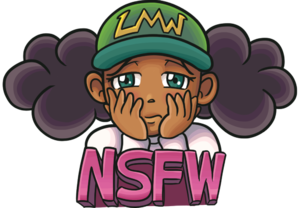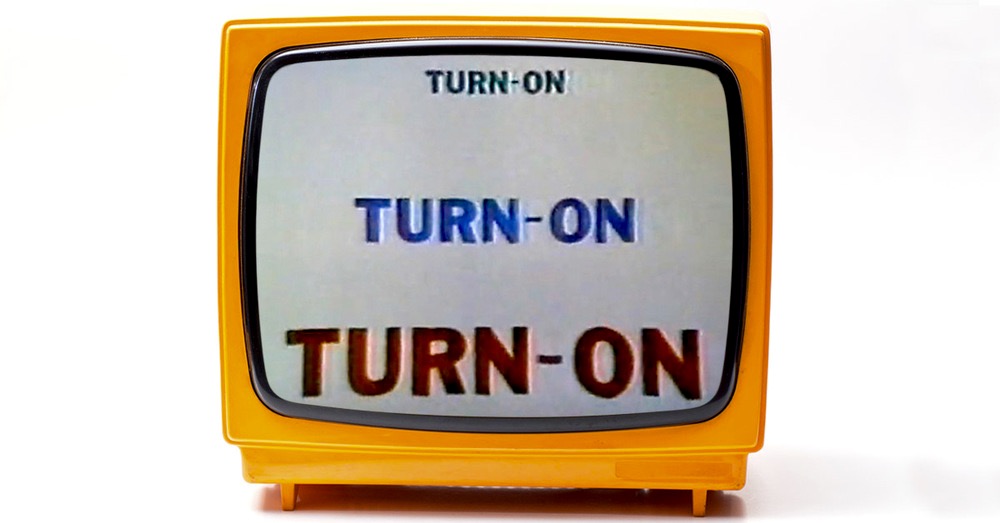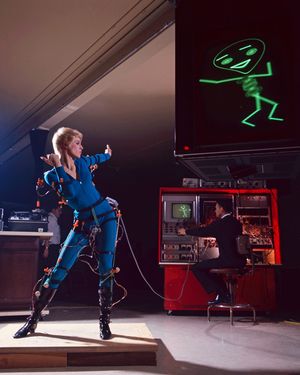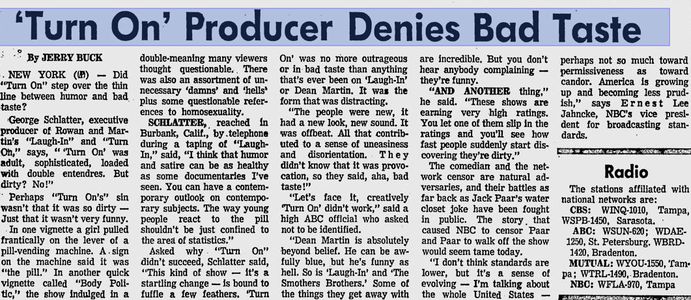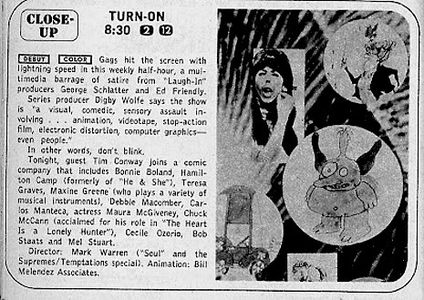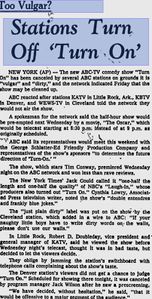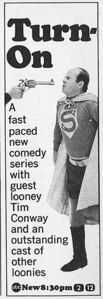Turn-On (found ABC sketch comedy series; 1969)
On February 5th, 1969, American TV network ABC premiered the experimental sketch comedy series Turn-On., which only hours later would become the first TV series in history to be cancelled not just after but during its first episode. By the time it reached the Central time zone, it was already being yanked off the air by outraged affiliate stations and was shortly after buried without trace by the network. The completed second episode along with any others in production were likewise never aired, and remain largely lost to this day.
Production
Turn-On was created by Ed Friendly & George Schlatter, producers of sketch comedy series Rowan & Martin's Laugh-In, which had premiered the previous year to great acclaim. As a result, there was great interest in what the duo would come up with next... which was, as it turned out, the same suggestive, progressive, boundary-pushing sketch comedy taken to what they considered its natural next level. This would be evident even in the new show's title, a play on the counterculture slogan 'Turn on, tune in and drop out."
Friendly and Schlatter envisioned a sketch comedy series that was so revolutionary it didn't even have a human host; the show was supposedly 'programmed' via a giant computer, which also provided the Moog synthesizer-heavy soundtrack. Production executive Digby Wolfe described Turn-On as a "visual, comedic, sensory assault involving animation, videotape, stop-action film, electronic distortion, computer graphics—even people." This would include the earliest form of motion capture technology.
The goal was never to allow the viewer to become comfortable, even for a moment.[1] There were no permanent sets - indeed, no physical backdrops at all - and no laugh track; only a rapid-fire series of quick cuts against a sterile white or black background, with the multimedia clips appearing randomly from different parts of the screen. The opening credits were likewise intercut throughout the program, with no end credits.
The 'people' included Teresa Graves, Hamilton Camp, Mel Stewart, Chuck McCann, and (eventually, at the behest of bewildered executives) a weekly guest host, which for the premiere was comedian Tim Conway. The only named recurring character was E. Eddie Edwards, a shoe salesman with a foot fetish.[2] Sketches were very short (mostly under 30 seconds) and - in keeping with the desire to discomfit its audience - adult-oriented far beyond anything airing on American TV at the time - a smutty stream-of-consciousness involving sex, race, sex, politics, sex, Auschwitz and of course sex. Often segments consisted solely of bizarre images or surrealist one-liners: "President Nixon now becomes the titular head of the Republican Party." The premiere episode featured over 30 such avant-garde snippets in just 25 minutes - a dizzying pace even by today's standards, and by contemporary ones, as it turned out, nigh-unwatchable.
Unsurprisingly enough, the pilot was rejected by two of the three major American networks - not only Laugh-In parent NBC but CBS, home of much more conservative programming. An executive for the latter confessed, "It was so fast with the cuts and chops that some of our people actually got physically disturbed by it." Rival ABC, however, eager to ride the cutting edge of this seemingly hot new comedy trend, approved the show for a projected 16-week run; no light commitment, given the hefty price tag that came with full production of such an effect-heavy series. Pharma company Bristol-Meyers was set to sponsor.[3]
According to Vulture magazine's history of the show, only two episodes had been produced as of the show's ignominious debut.[1] The second episode was hosted by actors Robert Culp & his then-wife France Nuyen; no other prospective hosts or production details for later episodes have ever been confirmed. However Andrew Sandoval, in The Monkees: The Day-By-Day Story of the 60s TV Pop Sensation, claims that the band made an appearance in a different unaired episode, meaning that filming on a full series may at least have been in progress.
Premiere and Cancellation
ABC scheduled Turn-On in the high-profile 8:30PM Wednesday night prime-time slot, as a replacement for the successful (and, in its day, similarly daring) soap opera Peyton Place. Whatever that audience might have been expecting, by all accounts they were resoundingly unimpressed by what they saw. As were outraged affiliate station managers, who were happy to be quoted as such in the newspapers the next day, alongside even more disgusted reviewers.
Several affiliates were upset enough after a pre-screening of the premiere episode to refuse point-blank to air it at all, including KBTV in Denver, Colorado, KATU-TV in Portland, Oregon and KOMO in Seattle, Washington. At WEWS in Cleveland, the station whose objections are most often cited as the final straw leading to cancellation, a spokesman claimed that the station's switchboard was "lit up" with protest calls, whereupon general manager Donald Perris summarily yanked the show off-air at the first commercial break (either 10 or 15 minutes in, depending on the source). As the screen cut to black an outraged Ferris was firing off a telegram to ABC president Elton Rule: "If your naughty little boys have to write dirty words on the walls, please don't use our walls. Turn-On is turned off, as far as WEWS is concerned."[4]
The Cleveland market's other primary ABC affiliate, WAKR in Akron, did not drop the program nor report receiving any complaints, but their general manager joined the growing chorus of protests against the show's "questionable taste". Station KATV in Little Rock, Arkansas aired the show as scheduled but reported viewers 'jamming the switchboard' with complaints. WFAA in Dallas, Texas opted to reschedule their airing for the following Sunday night at 10:30PM, with no better success. “The public reaction [to the rescheduling],” general manager Mike Shapiro said later, “was furious. ’How dare you?’ everyone screamed. Then they all watched it on Sunday night and wrote me and said, ’That was garbage. If you had any taste you wouldn’t have shown it at all.’"[5]
Thus besieged on all sides, yet deeply committed financially if nothing else, ABC hedged, announcing on Feb 7th that Turn-On was on hiatus. (As an amusing footnote, its replacement for the next week - the ABC Wednesday Night Movie that would start 30 minutes early - was The Oscar, itself a legendary critical and commercial disaster.) Throughout the flurry of media coverage, network executives made face-saving noises about reviewing and possibly revamping the show, but if that happened at all it apparently went nowhere, and Turn-On was turned off for good as of Feb 10th. Co-creator Schlatter would later claim that WEWS' Perris actively lobbied other affiliates prior to the broadcast to force the network cancellation, but there is no independent verification of this, and it's much more likely that the show simply doomed itself.
Even more tolerant critics complained that, unlike other TV counter-culture comedy experiments like Laugh-In and The Smothers Brothers, Turn-On just wasn't funny. "It wasn't a bad show," then-Los Angeles Free Press reviewer Harlan Ellison claimed, "it was just an awkward show." TV Guide pointed to the heavy emphasis on sex but also, interestingly, the lack of a solidly human element: "(T)here wasn't any sort of identification with the audience - just a bunch of strangers up there insulting everything you believe in." [3] In the end Turn-On was at best much too far ahead of its time, and at worst, an artistic misjudgement on a scale that had never before been achieved on American television.
Either way, it quietly sank without trace. The creators accepted their failure without further protest, with Schlatter quickly pivoting back to focus on Laugh-In - which as a much more accessible version of the same concepts would go on to a hugely successful run and a place in TV history. Schlatter was further pacified by ABC cutting him a generous deal "in which he’d get a full payout for the 16-episode order if he would accept that the two finished episodes would never again enter American living rooms. He took it, and Turn-On dissolved into myth." [1]
Availability
Aside from being a decisive factor in ABC's refusal the following year to pick up similarly groundbreaking sitcom All in the Family, the Turn-On debacle was more or less forgotten until the 1980s, when ABC News aired a report featuring footage from the show. It was revealed that the second episode, at least, had been completed. A clip from this episode was later uploaded to YouTube.
While the two known episodes can be viewed in full at The Paley Center for Media in New York City. However the episodes cannot be viewed outside of the Center, it is unknown if any other copies are available elsewhere.
One other clip from the series is known to be available: one of the interstitial "dancing" animations. These interstitials were especially notable as among the first use of both computer graphics and motion capture in television history, and were produced using the ANIMAC video synthesizer. The Turn-On clip can be found on Scanimate DVD-1, a disc compilation generated by both ANIMAC along with its successors CAESAR and Scanimate. The DVD is sold online by Dave Sieg, engineering historian, and owner and caretaker of the last functional Scanimate unit.[6] On April 18th, 2021, YouTube channel Ultimate History of CGI uploaded the clip under the title Turn On! Dancer (1969) - First dance motion capture.
On March 1st, 2021, another clip was uploaded to YouTube by user BlueFrog. The clip appeared to be from the first episode featuring a skit between an unknown actress and Tim Conway.
Modern critiques
On the Plus Two Comedy series Stay Doomed, hosts Laura Prince and Noah Houlihand visited the Paley Center for an episode about Turn-On. Both found the presentation unnerving in much the same way that contemporary viewers had, pointing out that the avant-garde soundtrack combined with the fast edits, spilt screens, random messages and credits across the screen, all against the disorientating blank background, made for uncomfortable viewing at best. They confirmed that in any case, screening such an experimental show in primetime 1969 was a mistake.
While Prince gave the show a strongly negative review, Houlihand was more positive, giving it a "stay tuned" rating and adding that the show was like a "...Vine compilation video, if it was produced by Tim and Eric". Comparing the show's format to modern dark comedies like Too Many Cooks, he noted that it would be at home on newer surrealist showcases, like Cartoon Network's Adult Swim.
Gallery
Images
Videos
Reference
- ↑ 1.0 1.1 1.2 Vulture - The ’60s Sketch-Comedy Show That Crashed and Burned Into TV Infamy. Retrieved 21 Jul '21
- ↑ Stay Doomed - Episode 36 Turn-On
- ↑ 3.0 3.1 The Show That Died After One Night: The Inglorious History of 'Turn-On,' a $1,000,000 TV Disaster. TV Guide, May 17–23 1969
- ↑ "Too Vulgar? Stations Turn Off Turn-On" Eugene, Oregon Register-Guard, Feb 8th 1969
- ↑ Interview with WFAA-TV general manager Mike Shapiro
- ↑ Scanimate's official website, where the DVD is sold. Retrieved 23 Aug '19
